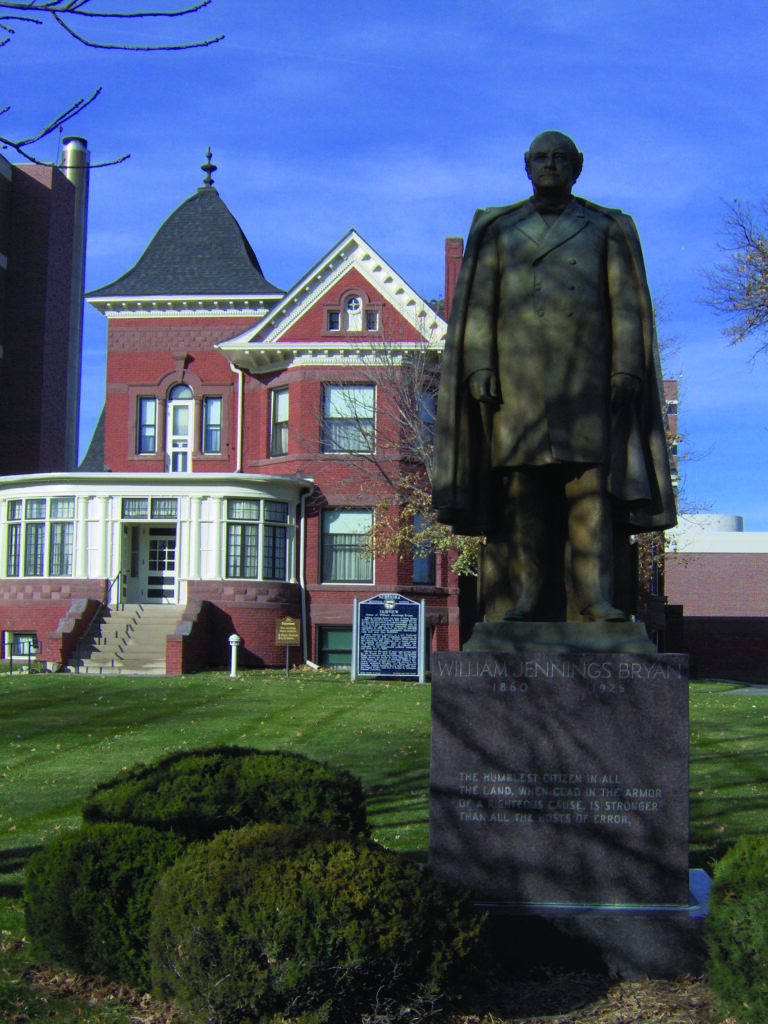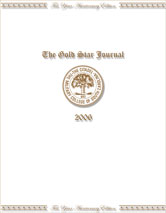Editor-in-Chief
- John H. Bergmans, Class of 2006, Political Science (International Politics) Major.

The Editors
- Matthew J. Harakas, Class of 2006, English Major.
- Timothy A. Devine, Class of 2007, History Major.
- Jason M. Russell, IV, Class of 2007, Business Administration (Accounting) Major.
“As the sun sets on a decade of hard work and dedication that have made this publication possible, this year’s editors and Dr. Mabrouk would like to take this opportunity to thank many members of the faculty and staff of the college for making and continuing to make the journal a great success…For the incredible strides made in the past, and for the many years to come, we shall endeavor to make the road less traveled a rewarding one for future generations of cadets and scholars.” -The 2006 Gold Star Journal
To view the entire 2006 edition, click this link or the cover above.
Featured Papers
“William Jennings Bryan: The Uncommon Commoner,” Brian J. Amen, Class of 2006, History.
In 1896, America was facing an economic and social crisis as the rural population began to dwindle and depression set in. The free coinage of silver was a largely popular solution to this calamity, and out in the plains there was a man who seemed to hear this cry, William Jennings Bryan. At the Democratic National Convention in Chicago, he stood before the crowd and declared to the pro-gold delegates present, “Having behind us the producing masses of this nation and the world, supported by the commercial interests, the laboring interests, and the toilers everywhere, we will answer their demand for a gold standard by saying to them: You shall not press down upon the brow of labor this crown of thorns, you shall not crucify mankind upon a cross of gold!” William Jennings Bryan, twice a Congressman from Nebraska, thrice a Presidential nominee, and never a Chief Executive, was arguably one of the most powerful orators of his day, but nothing more. He was a pulpit politician, driven by intense religious convictions with a desire to help the underclass, but with not enough conception of issues of his day to place him in the Oval Office.
“Magnesium: A Vital Link in Biological Function”, Anyanime A. Edem, Class of 2006, Chemistry.
The benefits of many minerals are well publicized today, such as calcium for bone growth. However, the importance and benefits of magnesium are not well known. Magnesium is abundant in nature, especially in plants and seafood. It is involved in the activation of more than 300 enzymes within the human body. Its functions include digestion, energy production, relaxation of muscles, and the functioning of the heart. Deficiencies can lead to heart problems, cancer, and diabetes. These diseases are prevalent in our society today and we can prevent them by increasing our intake of magnesium.
“National Security Space: Safeguarding the Space Medium Through Transformation, Technology, Integration, and Organization,” Matthew J. Henfey, Class of 2006, Political Science.
Italian Air Marshall Giulio Douhet once said, “In order to assure an adequate national defense, it is necessary – and sufficient – to be in a position, in case of war, to conquer the command of the air.” The Department of Defense is taking this quote and changing “command of the air” to “command of space”.
At the 2003 Military Communications Symposium in Boston, former Under Secretary of the Air Force Peter Teets, an employee of Donald Rumsfeld, gave a speech about the Transformation in National Security Space. The under secretary (Teets, 2003, para. 6) told a story of a combat controller in Afghanistan who combined a horse, a laptop computer, a global positioning satellite receiver, and laser goggles to pinpoint a target location for a B-52 flying overhead to provide close air support for ground troops ahead.
The senior leadership of our country is transforming the structure of our national security. Our technology in developing communication devices throughout the space medium is advancing as everyday passes and as we learn from our mistakes in the past, we are continually integrating our intelligence community to benefit our need for security in the future.
“Wealth or Attractiveness: Preferences for Mate Selection,” Harris C. Ligon, Class of 2006, Psychology.
This study primarily illuminated preferences between human mates. Specifically, members of four communities who posted personalized advertisements were examined and analyzed for preference towards attractiveness and wealth in the possible selection of a mate. Both males and females display similar partiality to probable mates that were attractive. Ironically, though, females exhibited a higher fondness for wealth than males. Past research has encouraged the concept that males traditionally focus on attractiveness over wealth and that females consider potential wealth over individual attractiveness.
“Failure of Leadership: The Differences Between a War and a Campaign as Illustrated by the Gulf War of 1991,” Alex M. Monte, Class of 2006, History.
The Gulf War of 1991 was a great example of how a military campaign should be fought, but a poor example of how to conduct a war. Unfortunately the intention of the Gulf War was focused on the symptoms of the situation instead of the cause of the problem, which was the elimination of Saddam Hussein’s regime. As a result, a great campaign victory was achieved without a conclusive triumph. This campaign prompted another war with Iraq in 2003 to finish the job of the first, the removal of Saddam Hussein from power. This paper analyzes the causes of the 1991 Gulf War and the response by the US in the initial phases of Saddam’s invasion of Kuwait. The victorious campaign over Iraq and its implications are discussed along with the errors in leadership decision making. The paper ends by revealing that the U.S. leadership did not understand the difference between a war with a solid resolution versus a campaign of mere military might.
The Personality Theories of Dr. Sigmund Freud and Dr. Carl Jung Applied to Vincent van Gogh, ” Mary C. Park, Class of 2007, Psychology.
This paper examines the personality of Vincent van Gogh by applying the theories of Dr. Sigmund Freud and Dr. Carl Jung. Although there are many differences between the analyses, they both concur that van Gogh uses painting to symbolize his unconscious desires. The two theories also agree that the overuse of his ego produced many of his problems throughout his life.
Featured Photographs
Brian J. Amen, 2006, History Major – William Jennings Bryan’s Childhood Home.

Ku-Chu Hsu, 2006, Electrical Engineering Major.




